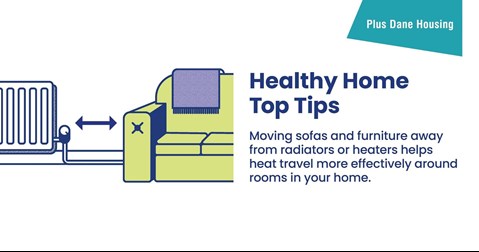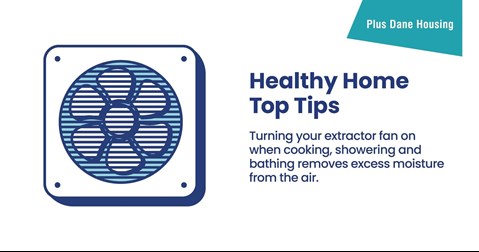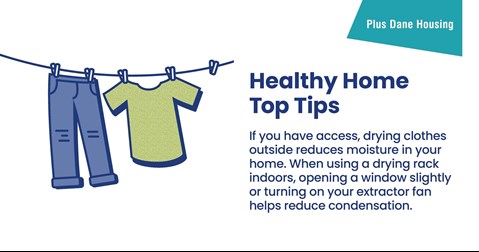Condensation is caused by the moisture in the air. It’s perfectly natural, and you see it at home when windows steam up or walls look wet. But over time, it can become a cause of damp and mould.
Mould looks like little black dots in the corners of the windows or anywhere water collects. Mould can be bad for your health, so it's important you take action if you spot signs of mould in your home.
Damp looks like a wet patch on a wall or ceiling and can be caused by things like leaks in the roof, guttering, drainpipes, missing pointing in brickwork, cracked render, rotten windows or missing air bricks. Left untreated, damp can cause structural problems over a long period of time.
Damp and mould can damage walls, furniture and even your clothes in the wardrobe, and cause health problems or make conditions like asthma worse.
Cooking, washing, and other activities in the home all release moisture, but there are simple things that can be done to make sure condensation does not turn into a problem.
Check out our hints and tips below and watch our short videos at the bottom of this page...



Mould usually looks like patches of little black spots and forms on walls, windows and ceilings. It can grow and spread and become a serious problem, but if caught in time it can be treated with household cleaning products like mould and mildew remover. Keep window vents open, especially in bedrooms where air flow can be poor. You can buy special fungicidal, or anti-mould paint to go over the area once it has been treated.
Click on the links below for our leaflet containing hints and tips in different languages:
الرطوبة والعفن في بیتك Arabic
رطوبت و کپک قارچی در منزل شما Farsi
شێداری و کەڕوو لە ماڵی تۆ Kurdish
ጠሊ ዘለዎ ቕርጺ ምጭባጥ Tigrinya
We are committed to making sure your home is a safe and healthy place to live.
Damp and mould can result in serious health problems, as well as causing damage to your home and furniture.
When you make a report, we will start looking into how to fix your problem straight away.
Social landlords including housing associations like Plus Dane, must now meet strict timeframes for investigating and resolving hazards following the introduction of Awaab's Law. View our leaflet on Awaab's Law which covers our legal requirement HERE
We have also created a leaflet to explain how we prioritise your damp and mould report to us HERE
The Biggest Change to Social Housing Regulation in a decade, so what does it mean for our colleagues and our customers...
Awaab’s Law is a landmark regulation in the UK social housing sector, introduced following the tragic death of two-year-old Awaab Ishak in 2020 due to prolonged exposure to mould in his home in Rochdale. The law aims to make sure that social landlords act swiftly to address hazards like damp and mould, which pose serious health risks.
It will come into force on 27 October 2025, with phased expansions in 2026 and 2027 to cover additional housing hazards such as excess cold, fire risks, and structural collapse.
Social landlords including housing associations like Plus Dane, must now meet strict timeframes for investigating and resolving hazards
Awaab’s law is set to become an implied term in social housing tenancy agreements and will include a definition of the different ‘hazards’.
A ‘significant hazard’ is one that poses a ‘significant risk of harm’ to the health or safety of a tenant of the social home. A ‘significant risk of harm’ is defined as ‘a risk of harm to the occupier’s health or safety that a reasonable lessor with the relevant knowledge would take steps to make safe as a matter of urgency’.
An emergency hazard is one that poses ‘an imminent and significant risk of harm’ to the health or safety of the tenant in the social home. An ‘imminent and significant risk of harm’ is defined as ‘a risk of harm to the occupier’s health or safety that a reasonable social landlord with the relevant knowledge would take steps to make safe within 24 hours’. This means issues that could cause immediate harm to the health or safety of tenants if not addressed quickly.
The teams at Plus Dane has been working hard to make sure we understand the changes to the regulations and that we are ready to adhere to them. We have already put in place additional processes and procedures for dealing with damp and mould and Awaab’s Law and the regulations provide a more formal structure and timescales to assist our work and make sure customers see a timely and structured response to hazards.
The safety of our customers and colleagues is our number one priority and understanding what we need to do is a key part of keeping everyone safe. This leaflet is designed to help Plus Dane customers and colleagues understand the requirements and put plans into action. If you have any questions or concerns about the content of this publication and Awaab’s Law, please contact us HERE
You can read or download this information in our leaflet HERE
Sometimes, damp and mould is due to an issue with your home. If you have tried our tips but it's not making a difference, please let us know. We take all reports of damp and mould seriously and will work with you to treat the root cause.